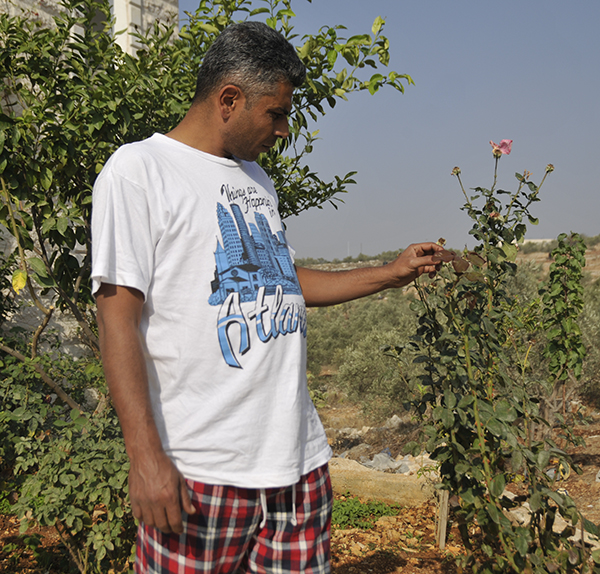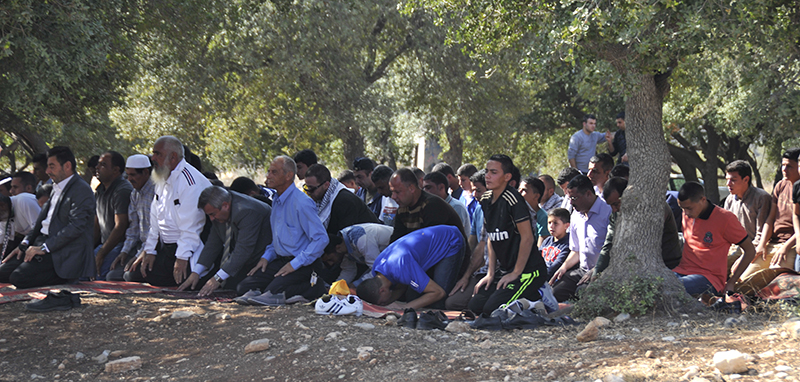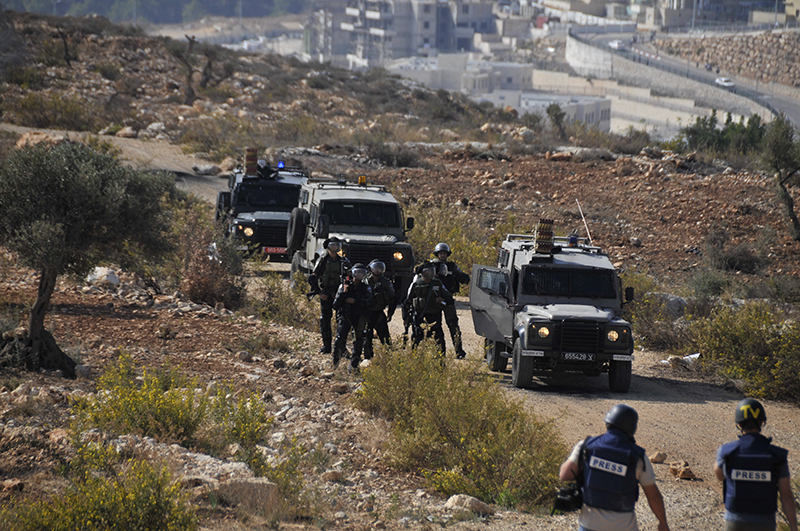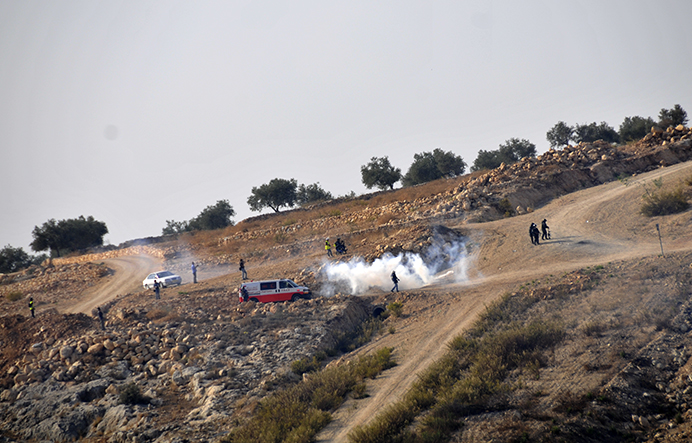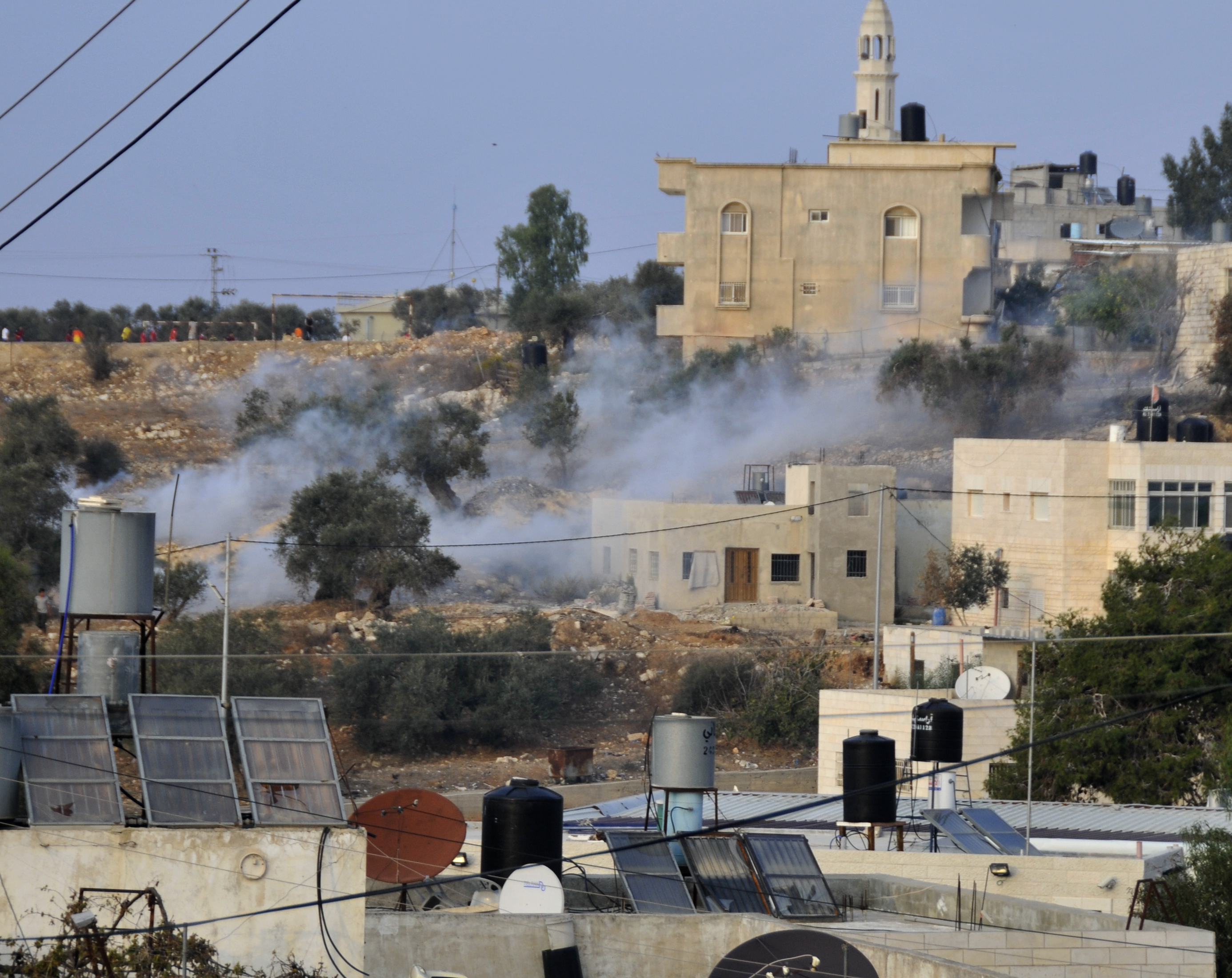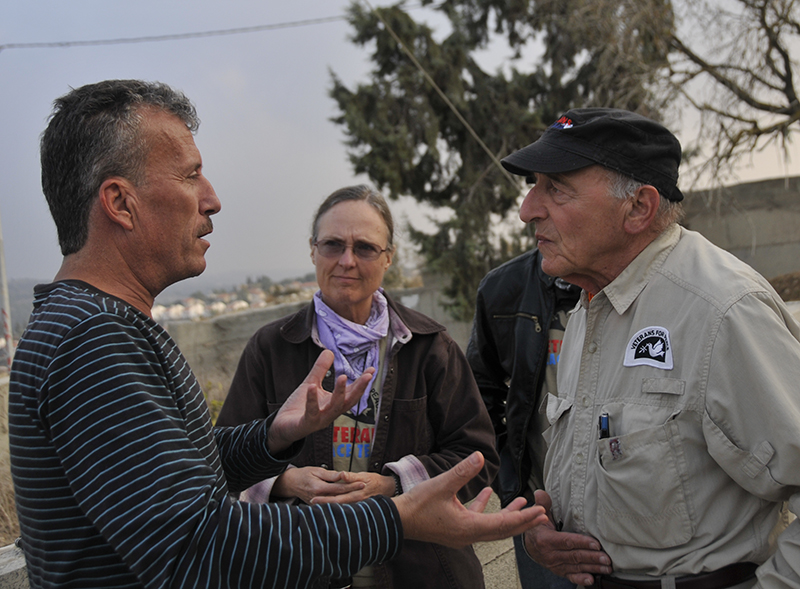Ellen Davidson is accompanying a delegation of U.S. military veterans in the West Bank. On Nov. 15, the delegation took part in the weekly demonstrations against the apartheid wall in the village of Bil’in. Below is the report from November 15. See reports from November 7, November 8, and November 10.
By Ellen Davidson
U.S. military veterans got a taste of some U.S. weaponry today in the village of Bil’in.
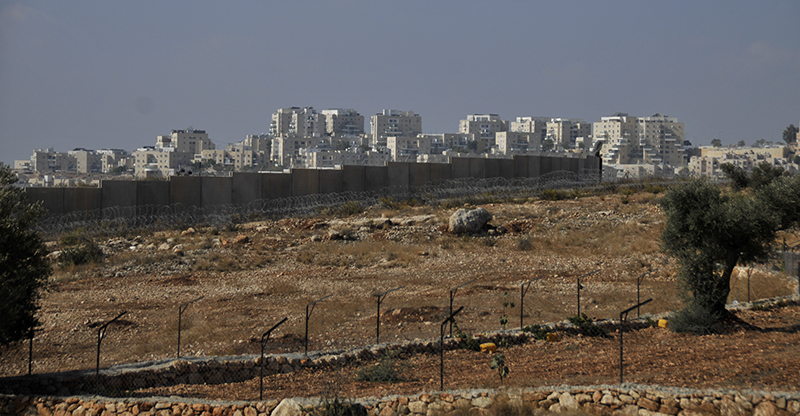
The wall divides the village of Bil’in from the settlement of Modi’in Illit, grabbing 60 percent of the village’s agricultural lands in the process. Photo by ELLEN DAVIDSON
The Veterans Peace Team delegation in Palestine encountered U.S.-made tear gas when they joined the weekly demonstration in the village of Bil’in, where Israel has been building part of its “separation barrier,” otherwise known as the “apartheid wall.” A large segment of the village’s land has been taken away by the wall, which separates the village from the enormous settlement of Modi’in Illit and the smaller settlement of Mattityahu East. Residents of the village took Israeli authorities to court and won a ruling forcing the Israelis to move the wall—the only time this has occurred so far—and they regained 200 acres of their stolen land, but the wall and its security buffer zone still incorporate 60 percent of village agricultural lands into the settlements.
The demonstrations, led by the Bil’in Popular Committee, have been held every Friday for nine years. The Palestinians have come up with many creative tactics, including enclosing themselves in metal barrels, creating a human “fence,” and locking themselves in a staked-down cage to block the bulldozers. The Israeli response has been violent, and for years, Bil’in residents have been subject to night raids and arrests, curfews, and military actions inside the village itself.
The Nov. 15 demonstration took place near the new route of the wall. At about 11:30, village men conducted prayers under the nearby olive trees. While the other protesters gathered, many Palestinians and internationals stopped to get their picture taken with the VPT banner and to express appreciation for our presence.
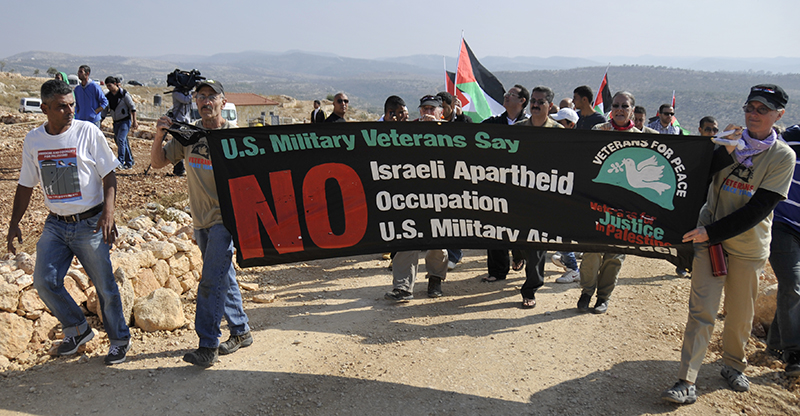
At the organizers’ request, the Veterans Peace team leads off the march. Bil’in Popular Committee leader Iyad Burnat is on the left. Photo by ELLEN DAVIDSON
As soon as prayers were over, the march set off, led by the Veterans Peace Team banner at the organizers’ request. Because the mayor was also joining the action, the protest followed a road that curved around a hill away from the wall and then back down toward it.
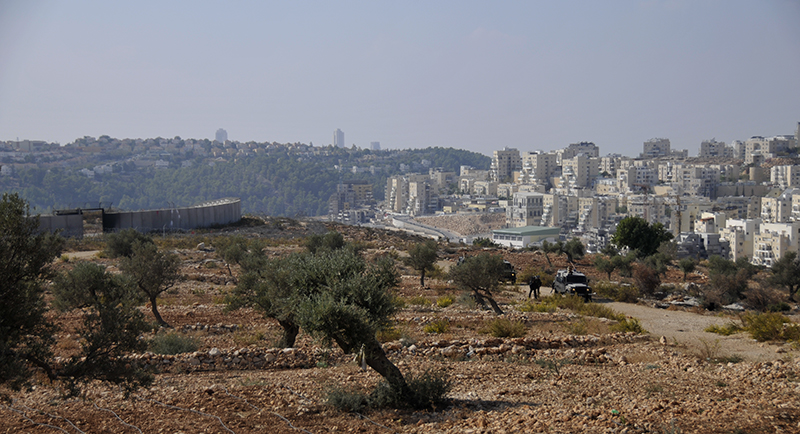
Israeli jeeps and troops guarding the wall. Behind them to the left is the hole where the gate used to be; to their right is the settlement of Modi’in Illit. Photo by ELLEN DAVIDSON
As we crested the hill and faced the wall, we could see two Israeli jeeps and soldiers standing about 100 yards in front of it. Behind them, we could see a gap where the gate had been spirited away by villagers the previous night. The marchers stopped, and a few young men with bandannas over their faces fanned out to our right. The soldiers shot some tear gas canisters in their direction, and the march organizers waved them back toward us.
Meanwhile, a number of photographers, including VPT members Mike Hastie and myself, started down the hill toward the soldiers. After a few minutes, protesters began slowly approaching the Israeli troops. This prompted a volley of tear gas that covered the hillside in dense fumes. One canister detonated about five or six feet from Mike Hastie, and I was surrounded on all sides by plumes of noxious vapors.
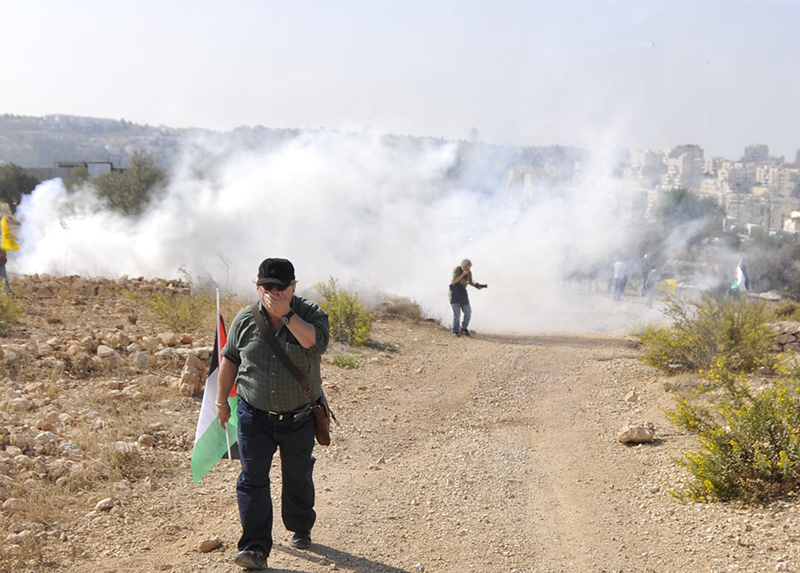
Vietnam War medic Mike Hastie (background) emerges from a cloud of tear gas–made in the USA. Photo by ELLEN DAVIDSON
“The tear gas was overwhelming,” said Hastie, “I couldn’t breathe, and I didn’t know what I was going to do, I was enveloped in it, and I could feel the early stages of panic, and out of the blue, this Palestinian guy grabbed my arm and took me in another direction out of the cloud. And I felt the solidarity.”
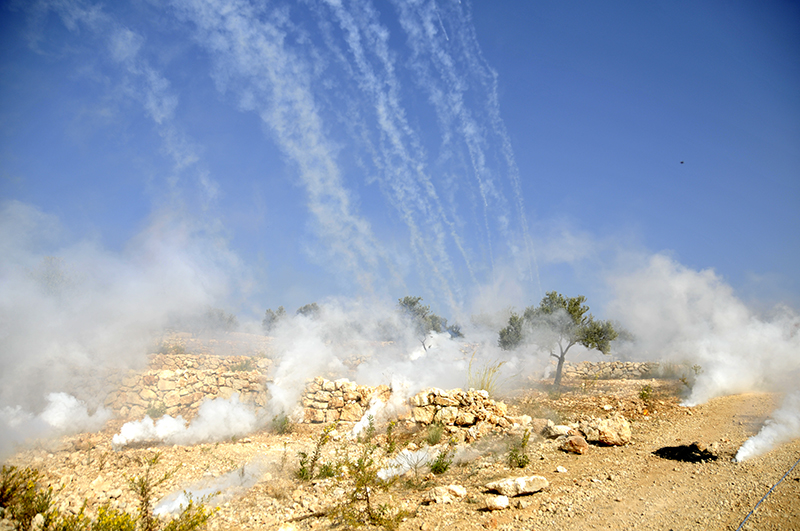
Clouds of tear gas bloomed from the olive trees. The Israelis have a launcher that can shoot up to 36 canisters at once. Photo by ELLEN DAVIDSON
As I struggled back up the hill, my skin was stinging, my eyes were tearing, and my lungs were screaming. I found the rest of the VPT, and the organizers urged us to move farther away, so we walked a half-mile back through the olive groves to the home of Iyad Burnat, the leader of the local Popular Committee who had hosted us the night before. Iyad’s 8-year-old daughter, Mayar, summoned me to the rooftop, where we could see the soldiers coming around to our side of the hill and lobbing more tear gas at the remaining protesters. The two ambulances, which had been picking up injured demonstrators, were not immune from attack. The acrid smell drifted across the valley to us, and Mayar covered her mouth and nose with her shirt. Her father told us that she had her first whiff of tear gas at one month old.
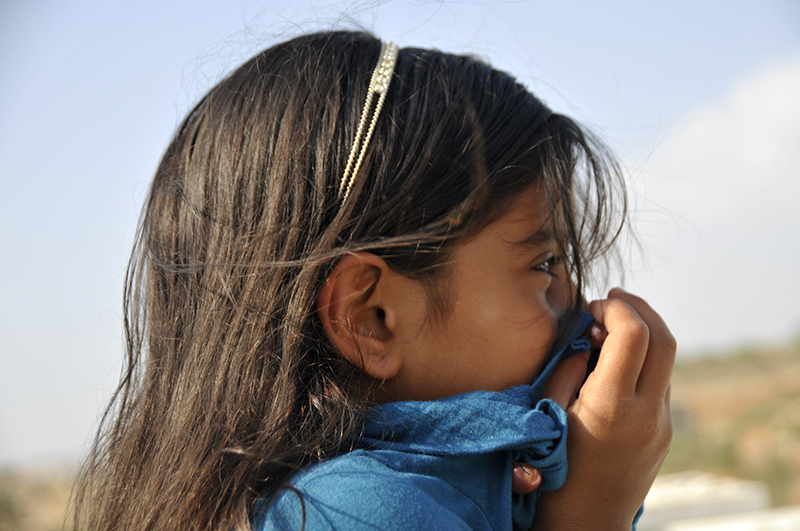
Eight-year-old Mayar, on her roof, tries to keep the fumes away. Her first encounter with tear gas was at age one month. Photo by ELLEN DAVIDSON
Tear gas and soldiers are a reality that Iyad’s children and the other village kids grow up with. His children have seen him arrested multiple times, his wife has been beaten with rifles in her home, and one of his brothers is in a wheelchair because of an Israeli bullet through his neck.
According to Iyad, this is just a part of the Israeli strategy to move people off the land: “I don’t have land, my family’s land is all behind the wall. This is my wife’s family’s land. In the future, it’s not just a problem for my children, but for all the children in the village. They don’t have places to build, they don’t have jobs, they don’t have water. So this is the goal of the Israeli government, to make the life hard for the people so they move from this land. It’s the same idea as 1948, when they forced the people with guns, killing people, and demolishing the villages. Now, they don’t want to do the same in front of the outside media, so they do something else, slowly, by making the life hard. In the future, if you don’t have a job, water, food to give your family, you have to find another place. So many of the young, in other villages, they leave to work in the United States or Europe.”
As we ate lunch serenaded by the sound of tear gas being fired in the distance, Iyad compared Palestinian culture with the United States, describing the value placed on community in the villages: “Every day you have people who are being killed in the United States by guns. The media don’t talk about this. They don’t talk about 2 million homeless people that don’t have places to stay.. They don’t talk about the soldiers coming back from Afghanistan or Iraq or other places that have problems. They don’t talk about 36 million people living below the poverty line. They don’t talk about this. So why do you give $4 billion to the [Israeli] army to kill people when your people need it? I saw young people living under bridges. Why? You can help them go to school, you can help them get apartments. Here in this village, for example, we have poor people, but they help each other. Without government, they help each other. If you want to do something, to build a home, to marry, you find all the people coming and giving you what you need. Ninety percent of my home is free—one brother did this part, another brother did the plumbing, my wife’s brothers, everybody helped. I have nine brothers, my wife has 12 brothers, everybody has his specialty.”
As we left an hour and a half later, the sounds of tear gas canisters still detonating in the distance, Iyad urged us to make a detour to the village of Nabi Salih, about 15 miles northwest of Ramallah, where Friday demonstrations are also held. Although, like Bil’in, Nabi Salih is threatened by a nearby settlement, Halamish, there is no wall nearby. The village is divided between what is known as Area B—under Israeli military and Palestinian civil control—and Area C, which is under Israeli military and administrative control. As we passed the checkpoint at the entrance to the village, Israeli soldiers were still firing at demonstrators some 200 yards away. Tear gas detonations punctuated our meeting with Bassem al-Tamimi, head of the Popular Committee.
The town of Nabi Salih has only 500 residents, most of them from the Tamimi family, Bassem explained to us. His own house, which lies partly in Area B and partly in Area C, is under a demolition order, like many others in the village. Although his family has grown, he cannot get a permit from the Israelis to expand his house. He described the history of violent Israeli military incursions into the village, showing us videos of soldiers firing tear gas and so-called “skunk water” (an extremely foul-smelling concoction that was created to be sprayed on demonstrators from trucks—the odor clings to the skin for days and cannot be washed out of clothing) directly into the houses, while the residents desperately tried to evacuate the children inside. He told the story of a woman who threw her baby out the window to waiting rescuers, which so traumatized the child that it refused to recognize her for two months. Other videos showed Israeli soldiers chasing and grabbing a 10-year-old boy from the streets, shoving aside his mother, who tried to prevent it. The child was interrogated for seven hours about who in the village was throwing stones and who was organizing the demonstrations.
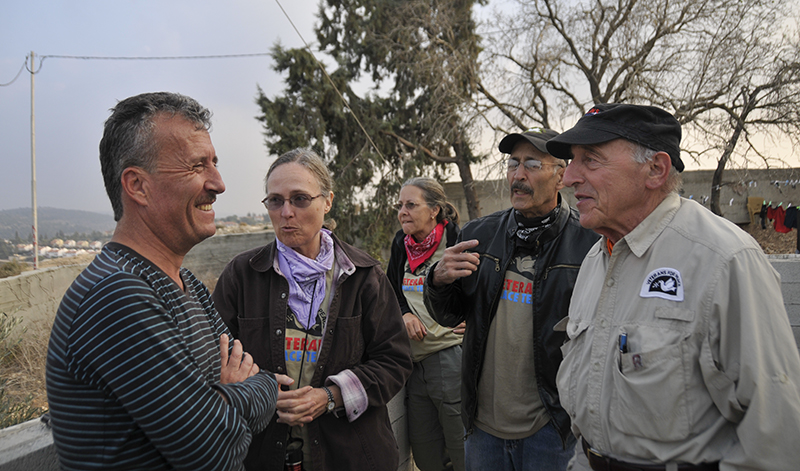
Nabi Salih Popular Committee leader Bassem al-Tamimi with members of the Veterans Peace Team. Photo by ELLEN DAVIDSON
Bassem told us what his wife told Amnesty International: “If they kill my brother in front of me, they destroy my house more than 10 times, and they take my computers, and when they arrest my husband, my son, they shoot me, they arrest me four, five times, how can you keep the peace? Can’t you see you are just making a report, you don’t do anything real on the ground? The soldier who killed my brother, I filmed him, and he said that I shot him. Nobody in the world did anything about that.” In the face of these conditions, Bassem and the Popular Committee’s continuing commitment to nonviolent resistance is remarkable.
Said VPT member Tarak Kauff, “The level of resistance in Palestine is considerably stronger than what we see in the United States, primarily because they are under more pressure, it’s a more compressed area. The children see their houses broken into, their homes destroyed, close family members killed, injured or jailed—and this is a regular occurrence—they grow up with it. You talk to any Palestinian in Bil’in, and either they have a family member who is in jail or has been killed or severely injured.”
Tarak went on: “The Israeli response to the nonviolent demonstrations has been extremely violent, and we wanted not only to experience and witness that, but to stand with the Palestinians as they wished. As it turned out, the lead organizer of the demonstration was determined to keep us safe. We got tear-gassed, but he made sure we were as safe as possible. I think we were all inspired to the point where we want to come back to Palestine. These are wonderful, deep, soulful human beings we’ve met on this trip, who have managed the incredible journey of staying human in the midst of tremendous oppression, and that I find impressive, and I want to be part of that.”
Mike Hastie echoed Tarak’s sentiments: “The more I was around the Palestinians, the more I felt the depth and warmth of their solidarity. After a while, I felt much closer to them, I just felt the struggle, because they are struggling for their lives. It’s as if they are on a ship that’s been torpedoed by the Israeli government and they’re still trying to survive and preserve their way of life and their humanity on a raft.”
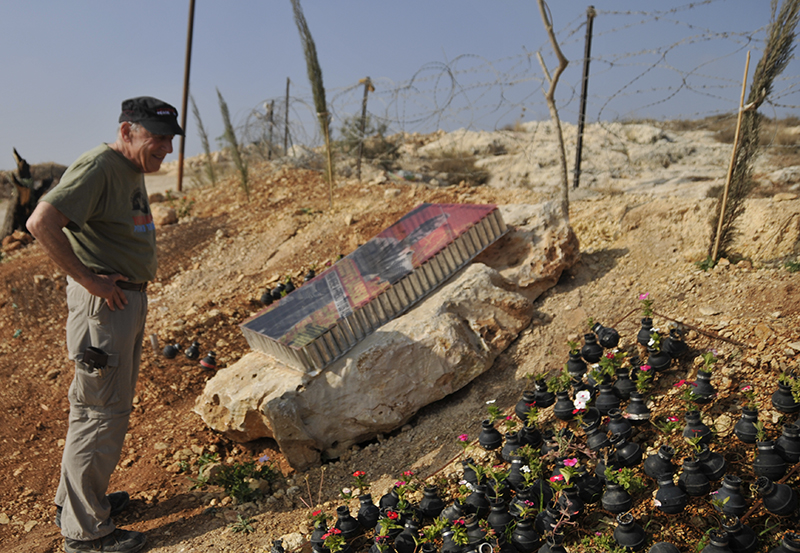
Ken Mayers visits the shrine to Bassem Abu Rahme, a BIl’in resident killed by Israeli soldiers during a nonviolent protest at the wall. Photo by ELLEN DAVIDSON
“What impressed me most about the demonstration in Bil’in,” said VPT member Ken Mayers, “was the discipline and the levels of organization, the levels of participation. The fact that men, women, and children, internationals, Palestinians, Israeli activists, were there represented a global resistance in a way that we haven’t seen before, or at least that I personally have not experienced before.”
VPT delegation member Lorna Vander Zanden said, “Participation with Iyad Burnat and colleagues in Bil’in and with Mahmoud’s action community in Al Masra, as well as meeting with the Tamimi family of Nabi Salih, are the essence of why Veterans For Peace needs to establish routine visits to Palestine. VFP can make a serious impact on the Palestinian plight by standing with Palestinians at their demonstrations.”
“Friday the 15th was the core of our reason for being here—interacting with and supporting the deepest Palestinian resistance and making terrific connections for future VFP delegations,” added Ellen Barfield.
Bassem al-Tamimi summed up: “We must join our efforts, and all of us put pressure, everyone. We must put our hands together, everyone who believes in peace and justice and freedom—freedom is life—and when we lose our freedom, we lose our life. For that, it’s very important to see you here and to have you here, and we would like to see you again and again and again.”

